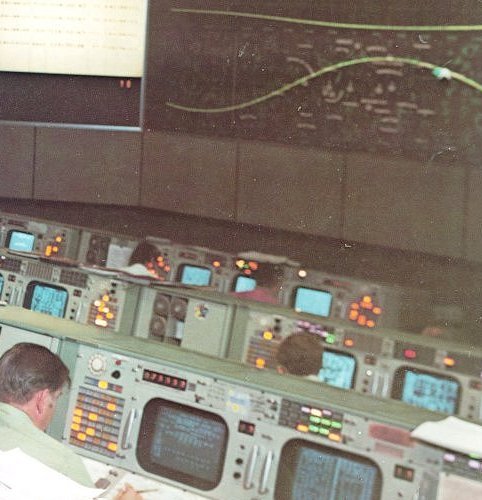Apollo Expeditions to the Moon
"This Is Mission Control"
By CHRISTOPHER C. KRAFT, JR.
| | |
The Mission Operations Control Room was the focal
point for all the activities of the Mission
Control Center. At any time during an Apollo
mission, one of the four flight control teams would be
manning these consoles. Each controller in this room
was supported in his operation by other
people and facilities, both in the staff support
areas within the building and in the world outside
the Center. Since the completion of the Apollo missions,
this room and the support areas have
been reconfigured for other manned space programs
like Skylab and Apollo-Soyuz.
|
The last Apollo flight to the Moon has been called "the end of the beginning".
It represented more than just the end of a program to me. It brought to a close a phase
of my career. Apollo had become intimately interwoven in the fabric of the waking
hours of my life and often caused the remaining hours to be fewer than they should
have been. My first involvement with the program had occurred at Langley Field, Va.,
11 years before the Apollo 17 flight. During those formative years of the lunar program
I was faced with the challenge of flying Mercury, and of necessity my commitment
to Apollo could not assume the proportions it would in later years. Only twenty-three
days before my first Apollo meeting at North American Aviation, we were flying
Friendship 7 and John Glenn on the country's first manned orbital flight.
In those naive early days I had no idea I would be charged with the responsibility
not only for flight operations but for managing the computer software programs that
would be used for landing two astronauts on the Moon and returning them to Earth.
Although in 1962 we had decided we were going to the Moon, we had yet to figure
out how we were going to get there and return, let alone determine the equipment,
facilities, and personnel we would need. Many difficult hours were yet to be spent in
conference rooms, visiting contractor plants and test sites, and waiting at airports.
I had yet to experience the frightening experience of disarming an angry young man
with a gun on one of many flights to Cape Kennedy. The future held both periods of
despair and frustration and those exciting and satisfying moments when we flew that
were to make it all seem worthwhile. Now, with Apollo 17, it was coming to an end.
I found it difficult to accept the finality of that landing on December 19, 1972, near
the USS Ticonderoga in the Pacific Ocean. The challenge would never again be quite
the same. Apollo was like an intoxicating wine and certainly the last of the vintage.
|

